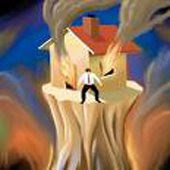There are at least two private companies in southern California that offer protection from wildland fires. From a story in the North County Times:
FALLBROOK —- The emerging business of private firefighting just got another competitor in North County.
Based in Fallbrook, Fire-Pro USA opened for business in April, said founder Don Green. That’s just a few months after the debut of another private firefighter, Pacific Fire Guard.
Fire-Pro differs from traditional firefighting by putting more stress on prevention and preparation, Green said. Public fire agencies use what he calls “the Ben Franklin model,” of waiting until a fire occurs and then dousing it with water.
Green, a veteran of firefighting, founded the company with partner David Wilterding last fall. Its services start at $519 per property per year. Fire-Pro will examine a customer’s fire risk, treat the property with a fire retardant and, in the event of an approaching fire, apply a heat-absorbing gel, Green said.
“That buys us time,” Green said of the fire retardant, which is clear and can be applied to surrounding brush as well as to the home. “We can spray this long-term fire retardant, and it literally makes their brush and wildland area a fire barrier.”
The fire retardant is not toxic to animals who eat the treated vegetation, Green said.
Pacific Fire Guard’s services cost $1,800 per year, according to a Feb. 9 story in the North County Times. The company also uses a heat-absorbing gel substance on property, and its firefighters will stay on the property until the fire threat has passed.
Nick Schuler, a Cal Fire spokesman, said homeowners who use such private firefighting companies still need to create a “defensible space” by clearing brush around their property for 100 feet.
“Cal Fire supports any homeowner who’s doing things to help reduce their fire risk,” Schuler said. “This does not replace defensive space, it does not replace good clearance and it doesn’t replace the need for having a protection plan for you and your family.”
Green said skepticism is understandable because Fire-Pro is so new. The company will have to prove its mettle by actually saving homes, he said.
The company may soon get that chance.
On Friday, Gov. Arnold Schwarzenegger issued an executive order ordering the California Department of Forestry and Fire Protection, or Cal Fire, to “immediately mobilize” its resources.
“This year’s fire season has already begun,” Schwarzenegger said in a Friday press release announcing the executive order.
Dry weather throughout the state in the last two months has heightened the risk of fire, Schwarzenegger said in the press release. In Southern California, dead and dying trees infested with bark beetles add to the fire risk, he said.
Trees stressed or injured by a lack of water are known to be susceptible to bark beetle infestation.
HERE is a link to a video of one of the companies applying a long term fire retardant to some property.




